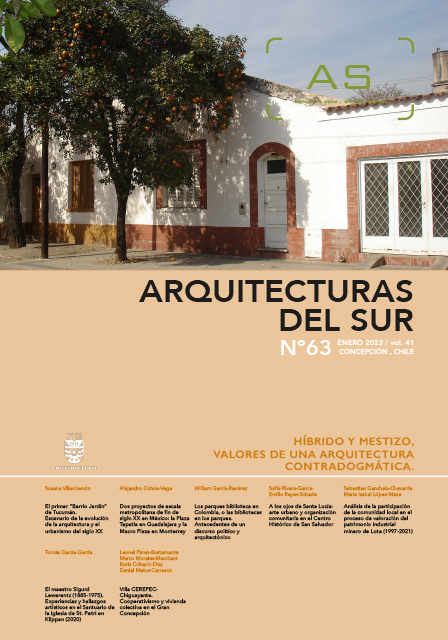The Master Sigurd Lewerentz (1885-1975). Experiences and artistic findings in the sanctuary of St. Petri Church in Klippan (2020)
DOI:
https://doi.org/10.22320/07196466.2023.41.063.06Keywords:
Sigurd Lewerentz, St. Petri in Klippan, site model, Alexander Calder, Italo CalvinoAbstract
In the archives of Sigurd Lewerentz, in Stockholm, there is an unpublished object that the master kept in a folder during the construction of St. Petri's Church in Klippan. A volatile fantasy in the form of architectural origami devised by Lewerentz as a delightful storyteller of the construction site. A delicate and fragile paper object, that captures and expresses well the artistic essence of this architecture, as a baked earth fold, as a lamellar brick structure that finds its resistance in its origami. An ethereal fantasy that will allow observing the work of the master through the eyes of Alexander Calder, recognizing both the intention of making air sensitive and putting our senses on edge. This story, through a life experience with the master's architecture, makes public certain spatial and artistic, musical, and mobile findings, through the study and production of the models made for the Sanctuary of the Church of St. Petri in Klippan. This space waits patiently for a breath, it lies dormant awaiting in the dark for the air to breathe life into it. This paper unveils a beautiful instrument, a surprising contraption devised by Lewerentz himself; a wind still that captures, conducts, and concentrates the sounds of nature itself, the sounds of Klippan.
Downloads
References
AA. VV. (1987). Sigurd Lewerentz. 1885-1975, Catálogo de la exposición. Madrid: Dirección General para la Vivienda y Arquitectura, MOPU.
AHLIN, J. (1987). Sigurd Lewerentz, architect, 1885-1975. Estocolmo: Ed. Byggförlaget.
CALVINO, Í. (1972). Las ciudades invisibles. Madrid: Ed. Siruela.
CALVINO, Í. (2018). Seis propuestas para el próximo milenio. Madrid: Ed. Siruela.
GARCÍA, T. (2012). St. Petri Kyrka: Väl värt et besök. Klippan: Klippan commun.
GARCÍA, T. (2017). Cartografías del espacio oculto. Laboratorio de experimentación arquitectónica. Tesis Doctoral Inédita. Premio Extraordinario de Doctorado por la Universidad de Sevilla 2018. Sevilla: Universidad de Sevilla, Sevilla.
GIMÉNEZ, C. (2004). Escritos y declaraciones, en AA.VV.: Calder: La Gravedad y la Gracia. Madrid: TF Editores.
HOLL, S. (2011). Cuestiones de Percepción. Fenomenología de la Arquitectura. Barcelona: Gustavo Gili.
MERLEAU-PONTY, M. (2010). Lo visible y lo invisible. Buenos Aires: Nueva Visión.
PALLASMAA, J. (2006). Los ojos de la piel. Barcelona: Gustavo Gili.
PARRA-BAÑÓN, J.J. (2020). Criptografía de la Arquitectura. Reseña bibliográfica: García García, Tomás. 2018. Cartografías del espacio oculto. Welbeck Estate en Inglaterra y otros espacios. Sevilla: Universidad de Sevilla-IUACC. Proyecto, Progreso, Arquitectura, (22), 14-15.
PEZO, M. (2013). La máquina inútil. Recuperado de: http://pezo.cl/wp-content/uploads/2013/12/0706_PEZO_LA-MAQUINA-INUTIL.pdf
PUENTE, C. (2006). Koan, en AA.VV.: Otras vías, homenaje a Lewerentz. Madrid: Colegio Oficial de Arquitectos Castilla y León.
SORIANO, F. (1999). Las texturas de la otra cara. Fisuras de la Cultura Contemporánea: revista de arquitectura de bolsillo, (7), 34-38.
VOGEL, P. (2011). The Sound of shadows [DVD]. Recuperado de: http://vimeo.com/19780802.
Downloads
Published
How to Cite
Issue
Section
License
Copyright (c) 2023 Tomás García-García

This work is licensed under a Creative Commons Attribution-ShareAlike 4.0 International License.
The content of the articles published in each issue of Arquitecturas del Sur is the sole responsibility of the authors and does not necessarily represent the opinion of University of the Bío-Bío.
The authors will maintain their copyright; however, they will guarantee the journal the right to first publication and dissemination of their work. The publication of the article in Arquitecturas del Sur will be subject to the Creative Commons International license (CC BY-SA) that allows others to adapt: remix, transform and build on the material for any purpose, even commercially; share: copy and redistribute the material in any medium or format, as long as the authorship and first publication in this journal are acknowledged by citing them correctly, and their new contributions are under a license with the same terms.














 Programa de Información Científica/Concurso Fondos de Publicación de Revistas Científicas 2018/ Proyecto Mejoramiento de Visibilidad de Revistas UBB (Código:FP180007)
Programa de Información Científica/Concurso Fondos de Publicación de Revistas Científicas 2018/ Proyecto Mejoramiento de Visibilidad de Revistas UBB (Código:FP180007) 
